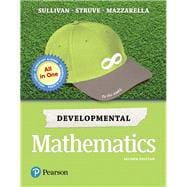Helps students innovatively "Do the Math"
Developmental Mathematics, 2nd Edition by Sullivan, Struve, and Mazzella utilizes the authors’ hallmark engaging features to introduce students to the logic, precision and rigor of mathematics, while building a foundation for success in future math courses. Known for their unique examples that give students extra step-by-step support, the authors have maintained their successful learning aids, and in this revision focused on translating it to the MyLab™ Math course–resulting in a truly dynamic print and digital learning and teaching experience.
To this end, the authors have created pre-built assignments for the accompanying MyLab Math course, making it easy for instructors to assign homework that utilizes all of the author-created learning features and leads to the best possible student outcomes. Developmental Mathematics offers market-leading content written by author-educators, tightly integrated with MyLab Math–the #1 choice in digital learning. Bringing the authors’ voice and approach into the MyLab course gives students the motivation, engagement, and skill sets they need to master algebra.
Also available with MyLab Math
MyLab™ is the teaching and learning platform that empowers instructors to reach every student. By combining trusted authors’ content with digital tools and a flexible platform, MyLab personalizes the learning experience and improves results for each student.
Note: You are purchasing a standalone product; MyLab Math does not come packaged with this content. Students, if interested in purchasing this title with MyLab Math, ask your instructor to confirm the correct package ISBN and Course ID. Instructors, contact your Pearson representative for more information.
If you would like to purchase both the physical text and MyLab Math, search for:
0134679342 / 9780134679341 Developmental Mathematics Plus MyLab Math with Pearson eText — Access Card Package, 2/e
Package consists of:
- 0134707656 / 9780134707655 Developmental Mathematics
- 0134896076 / 9780134896076 MyLab Math with Pearson eText - Life of Edition Standalone Access Card - for Developmental Mathematics










